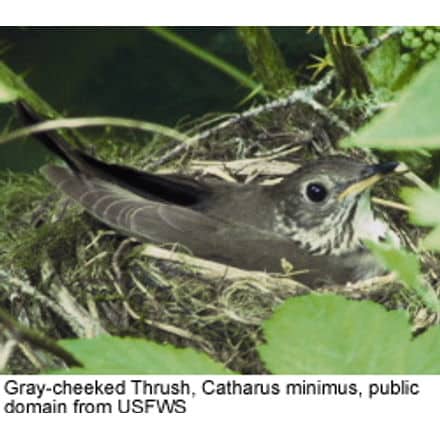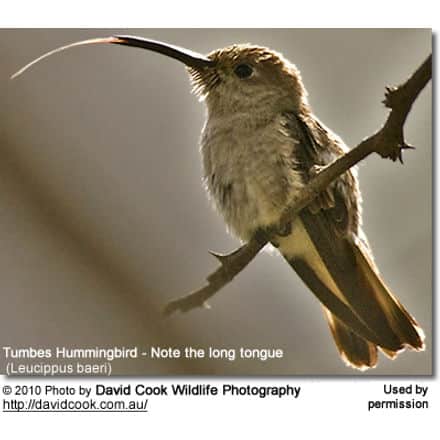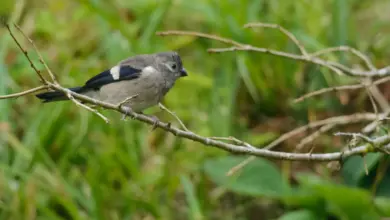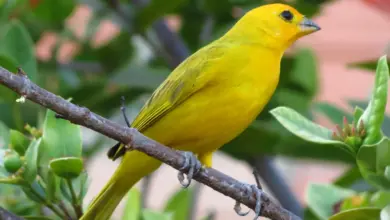Gray-cheeked Thrush, Catharus minimus
Thrushes

Distribution / Habitat … Subspecies, Ranges and ID
Description … Calls / Vocalizations
Breeding / Nesting … Diet / Feeding
The Gray-cheeked Thrush (Catharus minimus) are strongly migratory songbirds that breed as far north as Siberia, Alaska, and northern Canada and migrate to South America for the winter. These greyest of all North American thrushes have the most northern breeding range and migrate the longest distance of all small thrushes.
Until recently, the Grey-cheeked and Bicknell’s Thrushes were considered conspecific (the same species). Even though the Grey-cheeked Thrushes have a much larger range across North America than their close relatives, the Bicknell’s Thrushes are typically found closer to urban areas and are, therefore, more likely to be encountered.
Distribution / Habitat
Breeding / Summer Territory
The breeding territory of the Grey-cheeked Thrushes extends from northeast Siberia across northern Alaska east to northern Canada to north-central Quebec, Labrador, and Newfoundland; and west to northern Ontario, Manitoba, Saskatchewan, and northern British Columbia.
Habitat: high-latitude evergreen forests and arctic tundra; favoring areas with dense stands of stunted spruce and balsam
Migration
In fall, these birds migrate south for the winter. During the migration, they traveled mostly through the eastern two-thirds of the United States. They migrate mainly at night.
Habitat: dense undergrowth for foraging and cover
Winter Territory
They winter in the northern part of South America, specifically Colombia, Venezuela, south to Peru, and northwestern Brazil. Other populations spend the winter on islands of the West Indies.
Habitat: humid/wet tropical forests
Vagrants:
Rare vagrants have been reported in Europe.
Subspecies and Ranges:
- Northern Grey-cheeked Thrush (Catharus minimus minimus – Lafresnaye, 1848)
- Range: Breed in extreme northeastern Siberia, Alaska and Canada. Winter in northern South America (including Colombia, Venezuela, Peru, and Brazil), mainly east of the Andes mountain range.
- Western Grey-cheeked Thrush (Catharus minimus aliciae – Baird, SF, 1858)
- Range: Breed in southeastern Canada. Winter in the West Indies (an island group that stretches from Florida southward, then west along the north coast of the South American country of Venezuela)
Description
Size
Length: 6 – 8 inches (~15 – 20 cm), including the tail
Weight: 0.8 – 1.1 oz (24 – 30 grams)
Plumage Details / Adults
The back is dull olive-brown. Below spotted pale with greyish flanks.
Grey cheeks
Faint grey eyerings
Lower bill (mandible) flesh-colored
Other Physical Details
- Pink legs
- Slender bill with a pale base to lower bill (mandible)
Gender ID
Males and females look alike
Juvenile Description
Resemble adults
Similar Species
- Bicknell’s Thrush is very similar in appearance, except for its smaller size (average length 2.9 inches or 7.5 centimeters), shorter wings, buffier face and chest, and more noticeable eye rings. Otherwise very similar markings and very difficult to ID in the field. Most easily separated by their different ranges and vocalizations. The Bicknell’s Thrush is found in the northeast US and Canada – typically spruce-fir habitat above 900 meters or 3,000 feet.
- Swainson’s Thrush has bold buffy eye rings and buffy cheeks (not grey).
- Veery Thrush is smaller in size (6.5 – 7.75 inches or 17 – 20 cm in length), has a uniformly brown / more reddish plumage, lacks grey cheeks, and with only faint spotting on the chest.
- Hermit Thrush has a dull brown back, a distinct rusty tail, and a rump.
- Wood Thrush: Upper plumage is brown with a bright rusty-colored head. The plumage below is whitish with large dark spots.
Diet / Feeding
The Grey-cheeked Thrush consumes:
- insects and other arthropods, including beetles, weevils, ants, wasps, caterpillars, spiders, crayfish, sow bugs, and earthworms
- fruits and berries, including grapes, wild cherries, blackberries, and raspberries.
They mostly forage on the forest floor.
Breeding / Nesting
Grey-cheeked Thrush generally only produces one brood in a season; however, if the first one fails early in the season, they may have a second.
The open cup nest is constructed by the female out of dried grasses, twigs, moss, stems and other plant material, and the nest is reinforced with mud.
Their nests are typically placed on the ground at the base of a shrub or low in branches of shrubs.
A nest may contain 3 – 5 pale blue-green, eggs (average 4) with fine brown spotting. The eggs are incubated by the female for about 13 – 14 days.
The hatchlings are helpless and both parents feed and protect them.
Calls / Vocalizations / Sounds
Grey-cheeked Thrushes produce distinctive, high-pitched songs with quick chippers.
Alternate (Global) Names
Chinese: ???? … Czech: Drozd šedolící … Danish: Gråkindet Skovdrossel … Dutch: Grijswang dwerglijster … Estonian: tundrarästas … Finnish: Tundrarastas … Faroese: Vangagráur trøstur … French: Grive à joues grises … German: Braunkopf-Musendrossel, Grauwangendrossel … Irish: Smólach Glasleicneach … Hebrew: ????? ???????? … Icelandic: Hlýraþröstur … Italian: Tordo di Baird, Tordo guancegrigie, Tordo usignolo minimo … Japanese: haiirochatsugumi, haiirokotsugumi … Lithuanian: Blyškiaskruotis strazdas … Norwegian: Gråkinnskogtrost … Polish: drozdek szarolicy … Portuguese: Sabia-de-cara-cinza, Tordo-de-faces-cinzentas … Russian: Maly Drozd, ????? ?????, ????? ?????, ????????? ????? … Slovak: drozd sivolíci … Slovenian: aljaški cikovtnik … Spanish: Tordo de Cara Gris, Tordo de Mejillas Grises, Zorzal Cara Gris, Zorzal Carigris, Zorzal de Mejilla Gris, Zorzal Migratorio, Zorzalito Carigris … Swedish: Gråkindad skogstrast … Turkish: gri yanakl? ard?ç, Gri-yanakl? Ard?ç
Life Cycle
Their average lifespan in the wild is just over 7 years.
Species Research by Sibylle Johnson
Please Note: The articles or images on this page are the sole property of the authors or photographers. Please contact them directly with respect to any copyright or licensing questions. Thank you.





